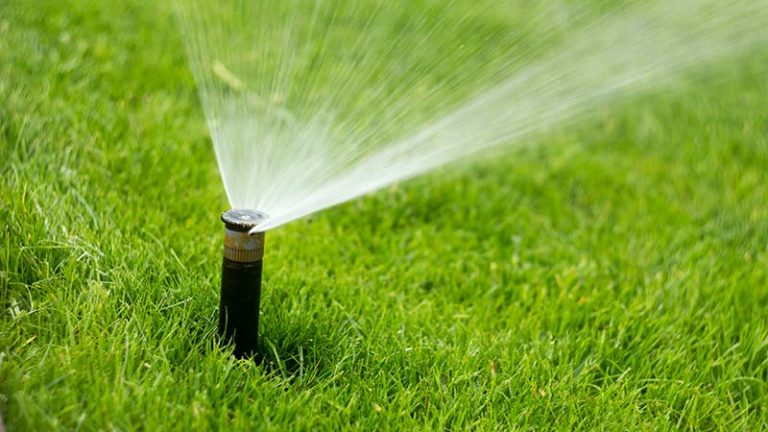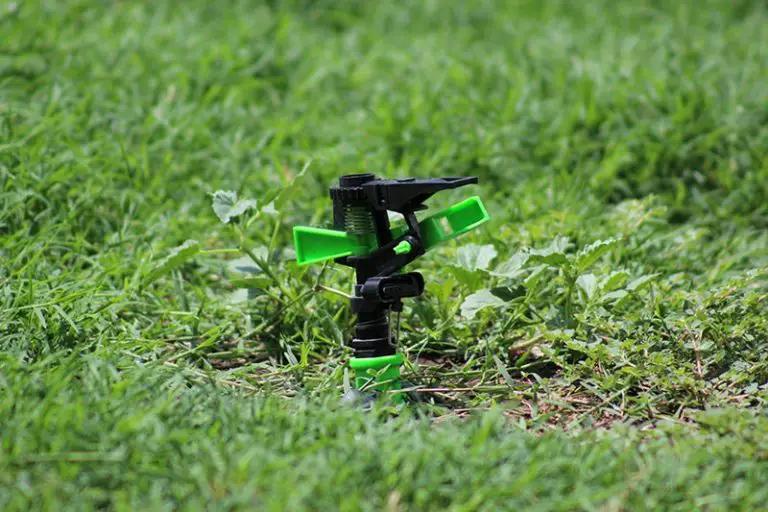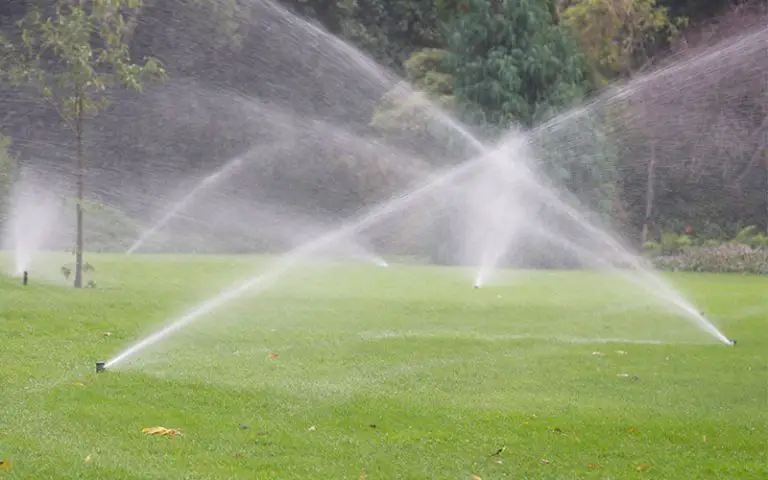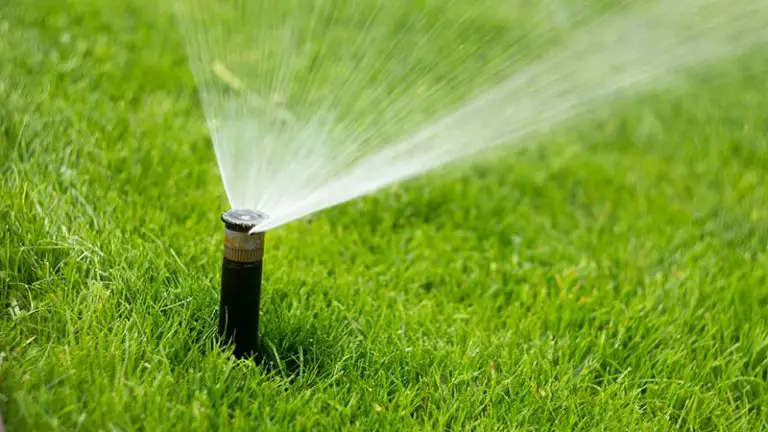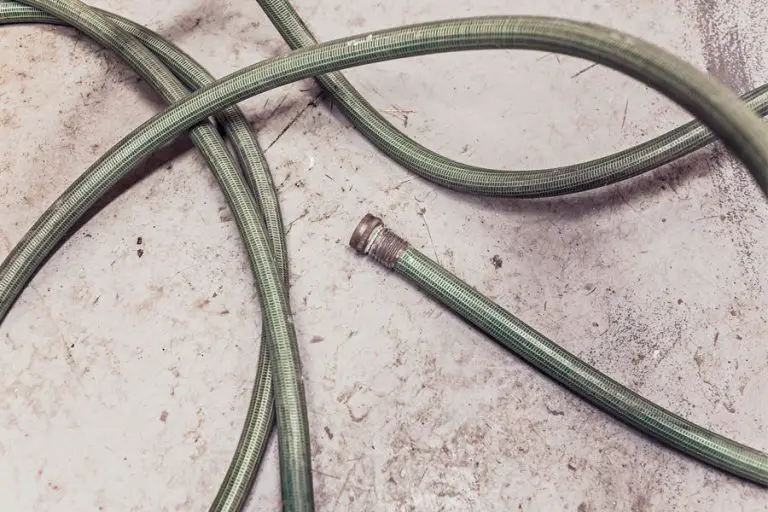Different Types of Lawn Sprinklers
Sprinklers come in many different shapes and sizes, each with their own benefits and disadvantages.
When looking to invest in a sprinkler, there are a lot of models to choose from, each with its own specialty. The type of sprinkler you choose should be decided using multiple factors, including lawn size and shape, level of water pressure, cost, and aesthetic amongst other factors.
What is a Lawn Sprinkler?
Like all plants, grass needs water to survive. So, during dry weather and drought, it’s important to ensure that your lawn is still receiving the care it needs to stay healthy.
Lawn sprinklers are designed to keep your garden lawn fresh and watered during dry weather. A sprinkler is used to irrigate your lawn and keep it well-watered. It sprays water at certain times of the day to ensure that your lawn or foliage is watered. Sprinkler systems can be built either below ground or above ground, but their purpose remains the same.
What Does a Lawn Sprinkler Do?
Sprinklers help keep your lawn watered during times of dry weather. They’re used mostly to keep grass soft and green, and help with the cosmetics of your lawn. Whilst sprinklers are commonly used to keep grass watered, they can also be used in flower beds or near hedges to supply them with water, too. Lawn sprinklers are, as the name suggests, used outdoors. Sprinklers can either be automated systems that work on a timer, or they can be manually turned on and off. As a result, they provide additional maintenance when maintaining your lawn and help you care for your lawn effortlessly.
How Do Lawn Sprinklers Work?
Lawn sprinklers can be installed in a variety of different ways that will help them care for your yard.
One of the more effective ways sprinklers are installed is through an inground system, which implants the sprinkler and its pipes underground. This keeps the components of the sprinkler hidden, thus avoiding any potential clutter in your yard.
The part of the sprinkler which produces water is known as the sprinkler head. The head of the sprinkler is responsible for maintaining pressure and releasing water appropriately. The sprinkler system is hooked up to a pressure system, but the head of the sprinkler can also affect the water pressure. The head of the sprinkler is often visible above ground to prevent pooling and to ensure that the water won’t be blocked by foliage.
In addition to the sprinkler head, the controller is the part of the sprinkler system which controls the pressure, amount of water used, and the amount of time in which the sprinkler is active. The controller is the very beginning of the sprinkler system and is also often buried in the yard along with the in-ground pipes. The controller often leads to several valves which control pressure, amount of water, and the individual heads that they’re attached to. This controller will also monitor how much water is used and how much water should be used. It can also ensure that certain areas of the lawn receive more water than others.
Most sprinklers mentioned in this list, however, are used as hose attachments. By using attachments, it’s easier to determine which sprinkler type works best in your garden and they can easily be switched out if conditions change. This is a much cheaper option to having an inground sprinkler system installed, but may not have some of the added benefits of having an installed system. These adapters use the pressure and water produced by the garden hose to water the lawn, and work with varying degrees of success based on various factors pertaining to your lawn and location.
What are the Benefits of a Lawn Sprinkler?
Lawn sprinklers assist in maintaining your garden, and as a result, are very beneficial in both practical and superficial ways. Due to the added ease that they provide, they help make watering your lawn less hands-on, and their automatic processes leave you with more free time.
In addition to this, lawn sprinklers provide an even amount of watering to each part of your garden providing their heads are placed appropriately, and can reduce the chances of overwatering or underwatering certain areas. As the number of water sprinklers used can be monitored and changed, they can also be much more efficient than relying on an instrument like a hose, which doesn’t provide any control over the pressure or amount of water used.
Sprinklers also keep your grass looking good and maintained. During long periods of dry weather, it’s likely that your grass will be showing visible signs of yellowing or browning due to the lack of water it’s receiving. Sprinklers help relieve these visible effects by ensuring that your lawn receives a natural amount of water when necessary, thus keeping it looking and feeling fresh and green.
Different Types of Lawn Sprinkler
There are several different varieties of lawn sprinklers, each type with its own benefits and disadvantages. Different types of lawn sprinklers work best in different types of yards, depending on size, amount of grass, amount of foliage, and price.
Oscillating Sprinklers
Oscillating sprinklers are considered fairly high quality. These sprinklers are above-ground and are easy to install and maintain. They often attach to a hose and work by spraying the water back and forth like a metronome. The pressure of the water keeps the oscillating sprinklers moving back and forth. They are often tube-shaped, with holes along the side which release the water once the pressure has built up. The tube rotates from side to side, in a waving motion, in order to water the lawn.
These sprinklers are an excellent option as they are cheap, easy to install, and easy to store when not in use. They often range from anywhere from $10-$40 and come in a variety of sizes to fit most lawn’s needs. They’re very popular due to their easy installation and cheap price and are often what people think of when sprinklers are mentioned.
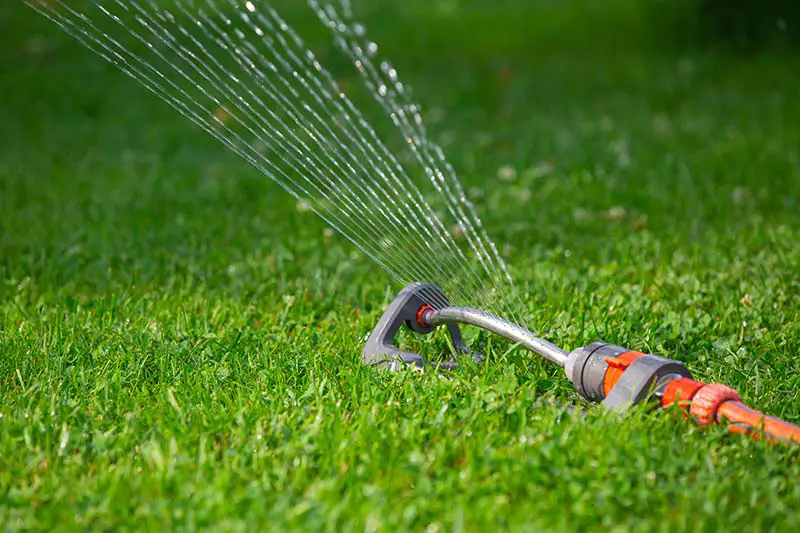
Travelling Sprinklers
Traveling sprinklers rely solely on the pressure that they produce in order to move up and down the lawn. They’re built like miniature tractors and rhythmically move up and down the lawn as they water it. The hose that they are attached to acts as a track, limiting their movement. Traveling sprinklers are best suited to larger lawns, due to the distance that they can travel. Whilst smaller ones are available, larger ones are easier to find and more abundant.
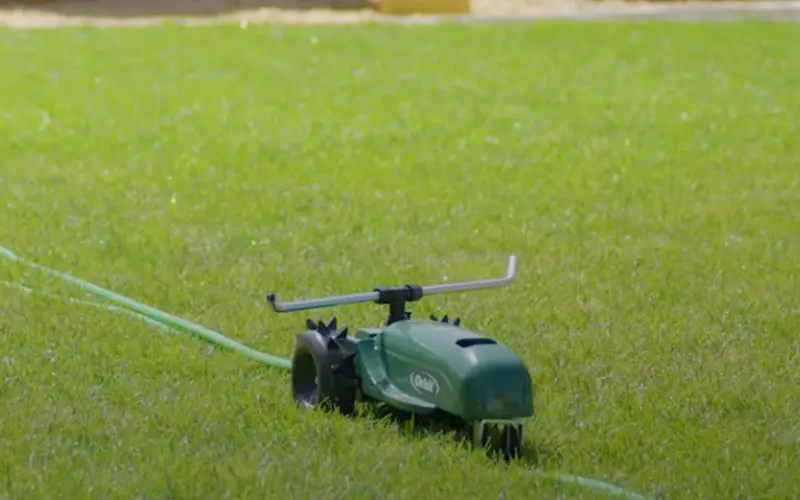
Stationary Sprinklers
Stationary sprinklers go by several names. They can also be called spike sprinklers or fixed sprinklers, but their concept remains the same. Stationary sprinklers, as the name suggests, stay fixed in one area and produce water to cover the area in which it’s placed. More than one stationary sprinkler is often employed to evenly water a garden, but they are most ideal for small yard areas due to their nature. Stationary sprinklers can also be easily moved around the lawn if need be, and need to be monitored to ensure that the immediate area around the sprinkler isn’t being overwatered.
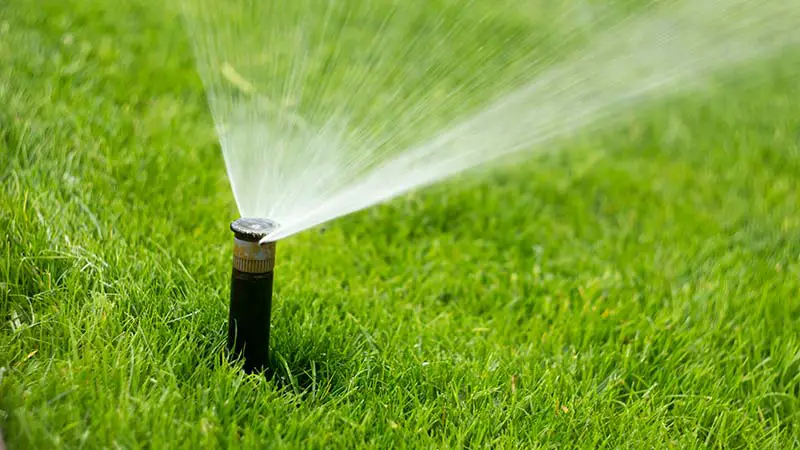
Pulsating Sprinklers
Pulsating sprinklers get their name from the movements they make when watering the grass. Their heads rotate whilst dispelling water, leading to a pulsating effect as the water is expelled. Pulsating, or rotating, sprinklers cover a large area of land and can disperse water equally using their movements.
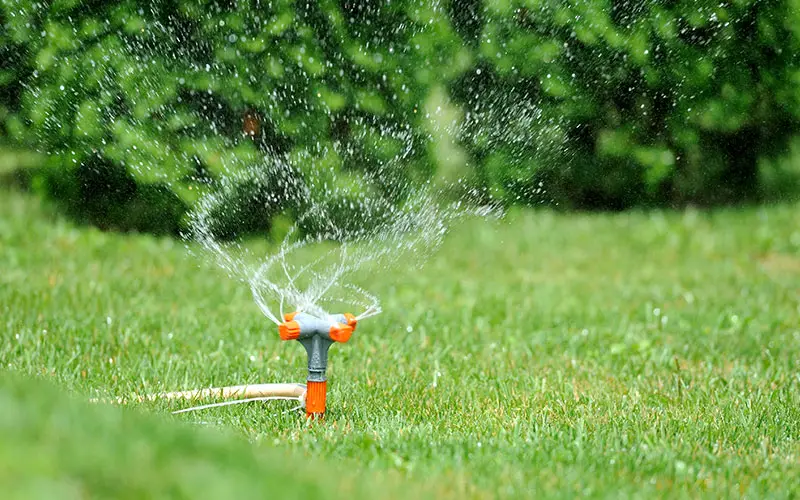
Impact Sprinklers
Impact sprinklers spray a continuous stream of water in a circular motion around the lawn. These sprinklers are popular for use on circular or irregularly-shaped lawns, due to the circular coverage that they produce. Impact sprinklers are also fairly wind resistant due to the density of the spray which they dispel, ensuring that the whole area which it covers will be watered.
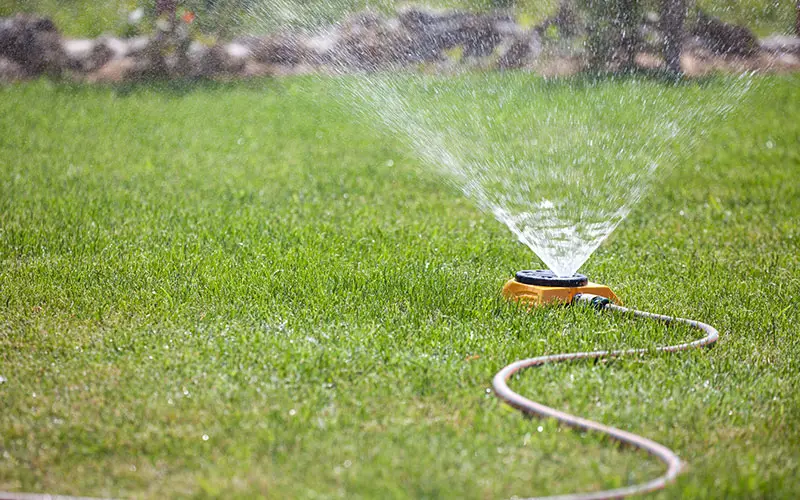
Sprinkler Hoses
Sprinkler hoses are exactly what they sound like. They’re hoses that have evenly spread holes that spread water around the area in which they’re laid out. Sprinkler hoses work similarly to oscillating sprinklers, minus the pendulum movement that makes oscillating sprinklers unique.
Sprinkler hoses are best used sparingly and on long pieces of grass or beds. This is due to the shape and the lack of distance that the water will reach. Sprinkler hoses may lead to some pooling if left for too long.
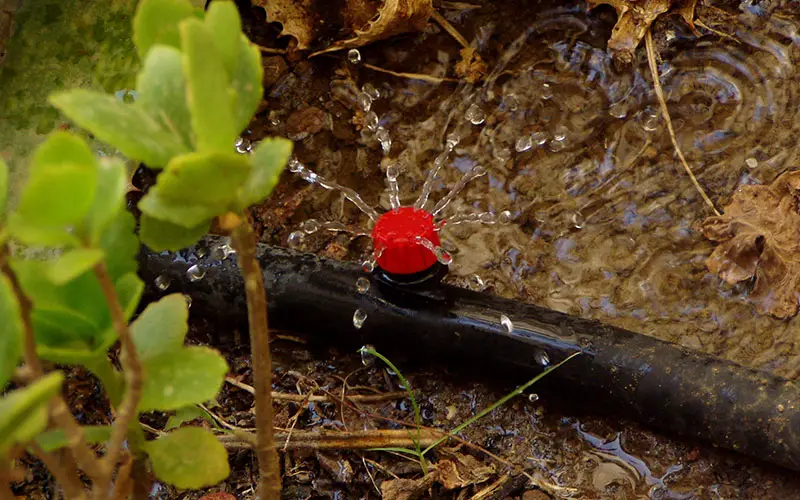
Inground Sprinklers
Inground sprinkler systems, as discussed earlier, are a system that controls various sprinkler heads using a control box. All pipes and equipment are buried underground, asides from the sprinkler heads, which remain above ground. This type of system is expensive to install but is the most effective way of watering a garden due to the specifically placed sprinkler heads which ensure an even and appropriate coverage whenever in use.
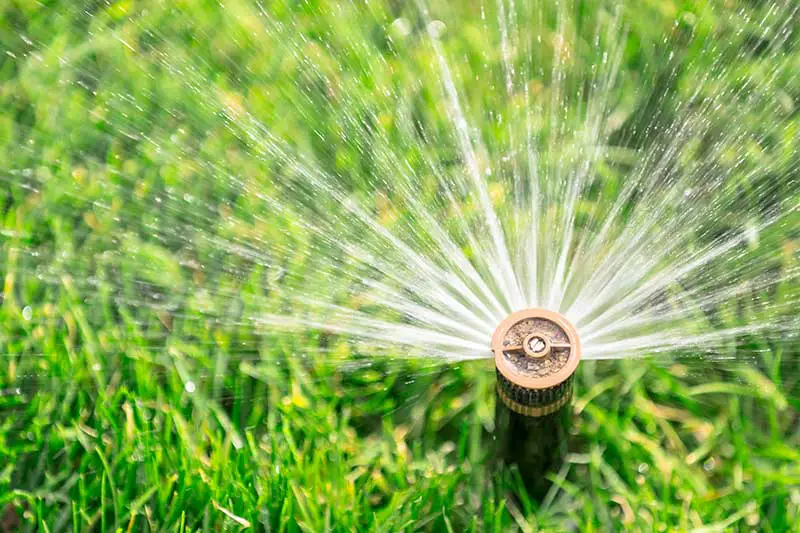
How Much Water Do Sprinklers Use?
The amount of water used by sprinklers depends on several factors.
Firstly, it depends on how often they are in use, which depends on the time of year and location in which you are based.
Secondly, the size of your yard will impact the amount of water used to hydrate it. Larger yards will, of course, require more water to maintain.
Finally, the type of sprinkler will impact the amount of water used. Some sprinklers may use more water than others, due to the pressure needed, the size of the head, and the length of the hose. Most sprinklers come with an estimate of how many gallons per minute (GPM) they use, so the easiest way to determine how much water your sprinkler uses is to measure how many minutes your sprinklers are on for and multiplying it by the GPM.
Things to Consider When Buying a Lawn Sprinkler
Some lawn sprinklers may not be a particularly expensive investment but can cost dearly in the long run if they don’t work as planned or lead to unwanted effects. In fact, grass can begin to yellow after only a couple of days in high heat without sufficient watering, and it can take even longer to reverse those effects.
Price
Whilst most sprinklers are fairly affordable, there are certainly ones of every type that are on the pricier side. Whether the added price is to reflect durability, reach, or size, it’s always important to read the reviews to see if what you’re paying for works as intended or whether you’re paying an extortionate amount for something which can be bought cheaper and work just as well.
Climate
The climate you live in can affect which type of sprinkler you need – if you even need one at all! Places that see frequent rain are less likely to need sprinklers to assist in watering, whilst places that are prone to drought will be more likely to need sprinklers to keep the lawn alive.
Coverage
The coverage of your sprinkler is very important to consider, as an even coverage will lead to less spotting and less pooling. When considering coverage, consider the size and shape of your yard, as certain sprinkler types work best for lawns of a certain shape. For instance, a rectangular or square yard will see more success with an oscillating sprinkler as opposed to an impact sprinkler.
The size of your yard is also worth considering, as certain sprinkler types are more effective in larger areas than others.
Pressure
Certain sprinkler heads require stronger pressure than others. If you’re aware that your water pressure isn’t always up to scratch, consider using a sprinkler that doesn’t require a great deal of pressure.
Adjustability
A good sprinkler is one that can be easily adjusted to fit your needs. Sometimes grass doesn’t need as much water as other times, so a sprinkler head that can be adjusted to fill the needs of your lawn is better than a head that can’t be adjusted.
Material
Most sprinklers are made to last, but some will prove to be more durable than others. Those that have a metal head and spike are more likely to survive being accidentally kicked or stepped on due to the more durable material. They’re also steadier when embedded in the ground, and are harder to relocate.
Convenience
Even though sprinklers are built for convenience, some are more convenient than others. There are sprinklers that are automatic, whilst some are manual. Both have their benefits and drawbacks, and it’s definitely something to consider when looking to purchase a sprinkler.
What the Sprinkler Looks Like
Some sprinklers are more aesthetically pleasing than others. Whilst the look of a sprinkler may not be everybody’s priority, some may prefer their sprinklers to be lowkey and out of sight.
Which Sprinkler is Best for Me?
When deciding which sprinkler will work best for you, you must consider the previous points listed above. Different sprinklers work best in different environments, and for different lawn types. The most important thing about a sprinkler is ensuring that it will do its job correctly and not lead to any damaging pooling. The most popular sprinklers are oscillating ones and pulsating ones – but they may not be ideal for your situation. When choosing your sprinkler, consider the size of the area which needs watering and the amount of water that it needs.

